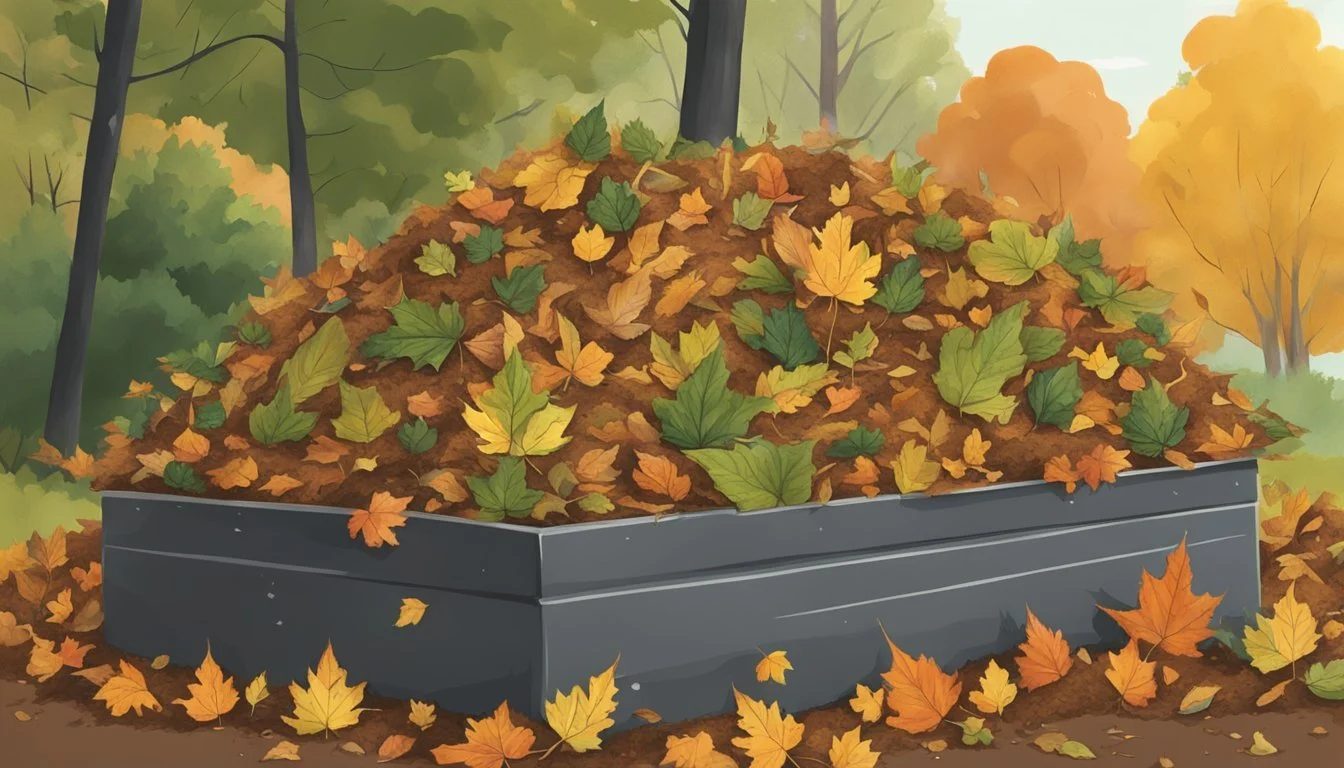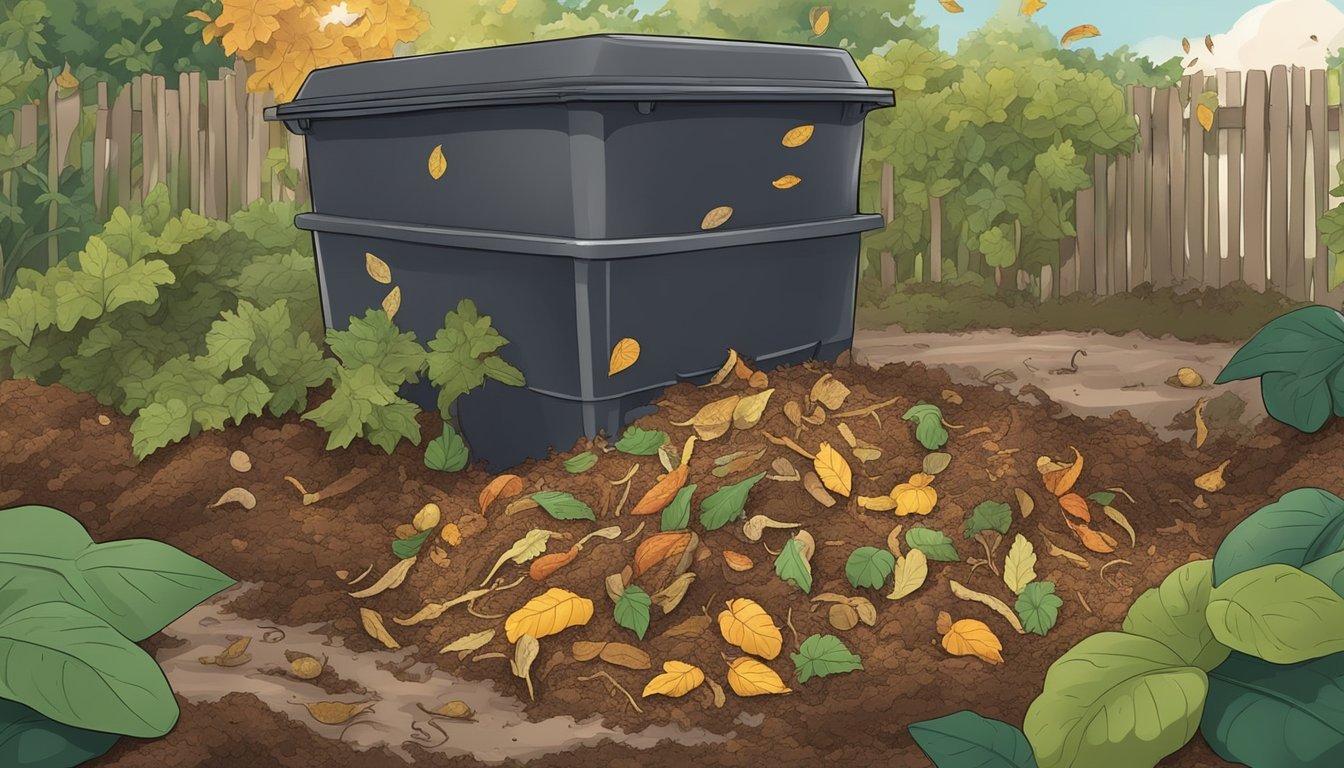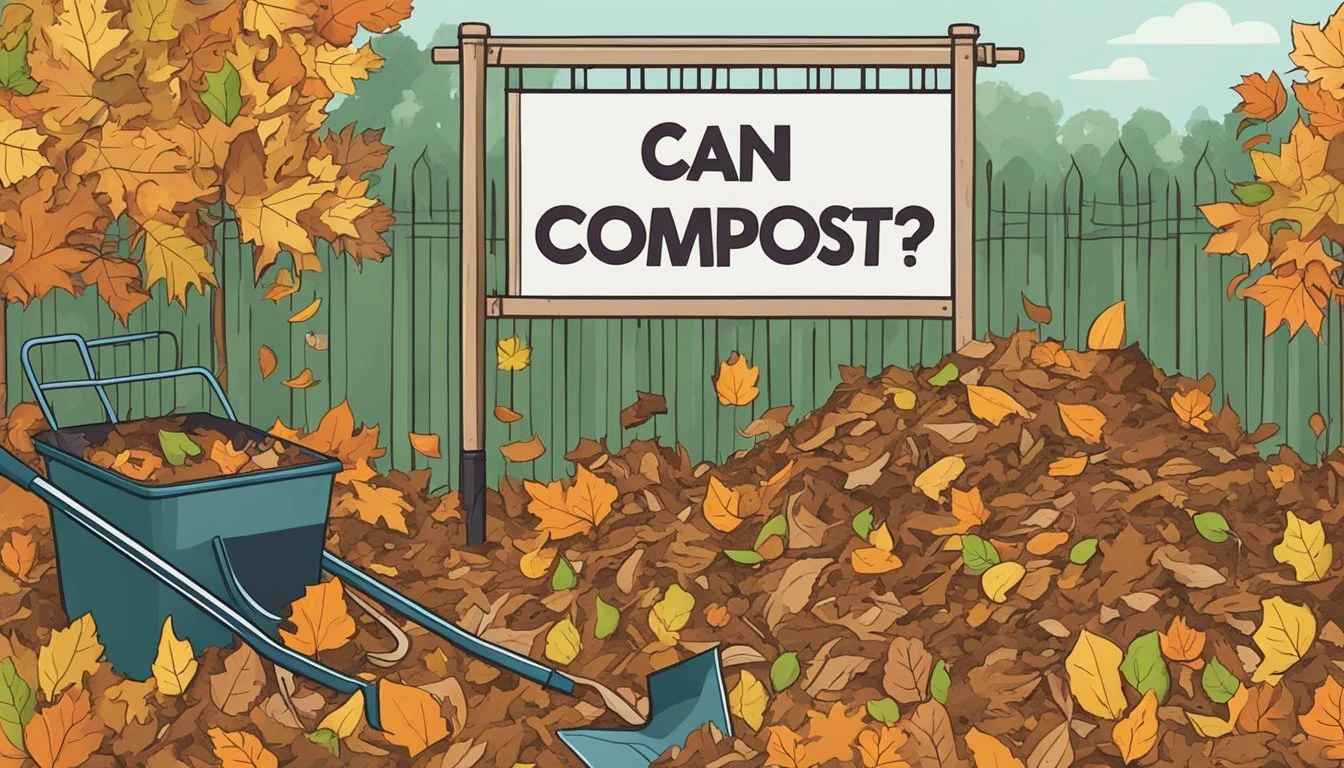Can You Compost Leaves?
The Definitive Guide to Leaf Composting
Composting leaves is a highly efficient and beneficial practice for any gardener or homeowner. Leaves, abundant and often readily available during the fall, are packed with essential nutrients and minerals that can significantly enhance soil quality. When these leaves break down, they provide a rich amendment to garden soil. By recycling leaves through composting, one creates a sustainable cycle, returning the tree's nutrients to the earth, enriching the soil that will, in turn, nurture plants and trees.
In addition to being a source of nutrients, the process of composting leaves also contributes to a healthy garden ecosystem in several ways. Compost improves soil structure, increases its ability to retain water, and helps to maintain a balanced pH level, which is crucial for plant growth. Moreover, utilizing leaves in this manner lessens the impact on landfills, as they would otherwise contribute to waste. With appropriate composting techniques, leaves can decompose effectively, becoming a part of a nutrient-rich compost blend.
While most types of leaves can be composted, certain varieties such as maple, poplar, and willow are known for their quicker decomposition rate due to their high calcium and nitrogen content. This quality makes them particularly valuable for accelerating the composting process. One should be mindful, however, of the carbon to nitrogen ratio in the compost pile to ensure efficient breakdown of materials, resulting in high-quality compost for garden use.
Benefits of Composting Leaves
Composting leaves provides a multitude of advantages for soil quality and garden vitality. It transforms a common yard waste product into a valuable resource that enhances garden health through several specific processes.
Soil Enhancement
Composting leaves improves soil structure by creating humus. Humus is an organic component of soil, formed from decaying leaves and other plant materials, which enriches the soil by improving its texture and its ability to retain water. When leaves are composted, they also increase the soil's pore space, allowing for better air and water movement through the soil.
Nutrient Recycling
The process of composting leaves effectively recycles nutrients back into the garden. As leaves break down, they release minerals and other nutrients that are absorbed by plants. This cycle maintains a balance in the ecosystem by returning valuable organic matter to the soil, thus reducing the need for artificial fertilizers.
Garden Health
Organic matter, such as composted leaves, enhances garden health by providing a natural source of nutrients. It also suppresses weeds and reduces the prevalence of pests and diseases. The inclusion of leaf compost promotes a thriving environment for beneficial organisms within the garden ecosystem.
Preparing Leaves for Composting
Proper preparation of leaves can expedite their transformation into nutrient-rich compost. Shredding increases surface area for decomposition, while balancing green and brown materials ensures an optimal composting environment.
Shredding Leaves
Shredding leaves before adding them to the compost pile is crucial. They can use a lawn mower with a bag attachment to shred leaves effectively. Smaller leaf particles increase the surface area, which speeds up the composting process and prevents the formation of mats that can impede airflow and water distribution.
Method:
Use a mower: Run over dry leaves with a mower to cut them into smaller pieces.
Heap and mow: Pile leaves and pass over them several times with the mower to ensure thorough shredding.
Balancing Green and Brown Materials
For a compost pile to function effectively, they must balance carbon-rich brown materials, such as shredded leaves, with nitrogen-rich green materials. An ideal ratio is 4:1 (brown to green) to maintain the pile's health and enhance decomposition.
Materials:
Brown: Shredded leaves (carbon)
Green: Kitchen scraps, grass clippings (nitrogen)
A balanced mix will encourage aerobic bacteria to break down organic matter, prevent unpleasant odors, and create high-quality compost.
Creating the Compost Pile
To ensure successful composting of leaves, the creation of a well-structured pile is essential. The reader will understand that careful attention must be paid to the composition of the materials, the regulation of moisture and aeration, as well as the management of the temperature within the pile.
Layering Your Materials
A balanced compost pile requires a mix of green and brown matter. Start by alternating layers of leaves (brown, carbon-rich material) with grass clippings or kitchen scraps (green, nitrogen-rich material). For optimal decomposition, aim for a ratio of about 4:1 of brown to green materials. The inclusion of soil in layers can introduce beneficial microorganisms that aid the breakdown process.
Maintaining Moisture and Aeration
The pile should be kept damp but not saturated with water. A moisture level similar to a wrung-out sponge supports composting bacteria, so occasional watering may be required during dry periods. Aeration is equally vital; regular turning of the pile with a fork or shovel ensures proper oxygen distribution, which prevents anaerobic conditions and speeds up the composting process.
Managing Pile Temperature
The heat generated by microorganisms during the composting process is essential for breaking down the materials. The temperature of the pile should ideally remain between 130-160°F to facilitate the decomposition of leaf matter and kill off weed seeds. Insufficient heat may indicate the need for more green materials or more frequent turning to reintroduce oxygen and rekindle microbial activity.
Remember, these practices will ensure that your compost pile transforms leaves into a nutrient-rich additive for the garden efficiently and effectively.
Optimizing the Decomposition Process
Composting leaves effectively requires specific techniques to optimize the decomposition process. Implementing practices such as regular turning, monitoring the stages of decomposition, and the use of appropriate additives ensures that leaves decay at an accelerated rate, transforming them into nutrient-rich compost.
Turning and Mixing
Regular turning and mixing are crucial for maintaining an active compost pile. They should aim to turn their pile every week or two to aerate the pile and evenly distribute the heat and microbes that break down the organic material. Clever mixing introduces oxygen, which is essential for microbe activity and helps prevent matting and odor issues that arise from anaerobic conditions.
Monitoring Decomposition Stages
They must monitor their compost pile to identify which stage of decomposition it's currently in. Initially, the pile will heat up as microbes actively break down the material; this is the thermophilic stage. Subsequently, the pile will cool down, entering the curing or maturation stage. Observing these phases allows one to determine when to turn the pile and when it's ready for use.
Using Additives
To speed up the decomposition of leaves, they can introduce additives to the compost pile:
Nitrogen sources: These are essential to balance the carbon-rich leaves. Ideal nitrogen sources include manure, coffee grounds, or grass clippings.
Structural additives: Straw or small twigs can help improve aeration and prevent compacting, which can slow down the decomposition process.
By incorporating these methods, one can efficiently transform leaves into compost that benefits the garden's soil health and fertility.
Common Challenges in Composting Leaves
Composting leaves can transform garden waste into gold for the soil, but several challenges can arise in the process. These include managing moisture levels, mitigating the impact of problematic leaves, and breaking down resistant leaf types.
Managing Wet Leaves
Wet leaves can create a dense, oxygen-starved environment within a compost pile. This problem often leads to anaerobic conditions, which slow down the composting process and produce an unpleasant odor. Gardeners need to balance moisture by mixing in dry, carbon-rich materials like straw or shredded newspaper to maintain aeration.
Dealing with Diseased or Toxic Leaves
Leaves from diseased plants or those treated with pesticides or herbicides can introduce harmful pathogens or chemicals into the compost. It's crucial to identify and separate leaves from plants like black walnut, eucalyptus, cherry, or elm that may contain compounds toxic to other plants before adding them to the compost.
Incorporating Tough or Waxy Leaves
Some leaves, such as those from oak trees, are particularly tough or waxy and decompose slowly. Gardeners can overcome this issue by shredding the leaves to increase surface area, which accelerates their breakdown. Incorporating green materials like grass clippings can also help balance the carbon-rich leaves with nitrogen, aiding in faster decomposition.
Using Leaf Compost in Your Garden
Leaf compost enriches garden soil, serves as an effective mulch, and functions as a versatile soil amendment. It contributes to the nutrient content, water retention, and soil structure necessary for a thriving garden.
As Mulch
When used as mulch, leaf compost acts as a protective layer over garden soil. It helps to:
Retain soil moisture by reducing evaporation.
Regulate soil temperature during seasonal changes.
Suppress weed growth, thus lessening the need for manual weed removal.
Gardeners should apply a layer of 2-3 inches of leaf compost around plants, ensuring they avoid direct contact with stems to prevent rot.
Incorporating into Garden Soil
Incorporating leaf compost into garden soil is a technique used to enhance soil consistency and fertility. Gardeners should mix finished leaf compost into the top 6-8 inches of garden beds to:
Improve soil aeration for healthier root systems.
Enhance the soil's ability to hold nutrients and water.
Regular incorporation of leaf compost can rejuvenate poor soils over time, making them more productive.
As Soil Amendment
Leaf compost is an excellent soil amendment for its ability to balance pH levels and introduce beneficial microorganisms. When leaf compost is added to garden soil, it:
Provides a slow release of nutrients such as nitrogen, phosphorus, and potassium.
Improves the soil structure, making clay soils more drainable and sandy soils better at retaining water.
To amend soil effectively, gardeners should evenly distribute leaf compost over the soil surface and then till or mix it into the soil before planting.
Environmental Impact of Leaf Composting
Leaf composting plays a significant role in environmental conservation by managing organic waste and reducing contributions to landfills, thereby mitigating climate impact.
Reduction of Organic Waste
When leaves fall from trees, they become a form of organic waste that can accumulate in garden spaces and urban areas. Composting these leaves converts them into a valuable soil amendment, thus repurposing what would otherwise be considered waste. This process diminishes the need for synthetic fertilizers, as compost provides a rich source of nutrients essential for healthy plant growth.
In terms of quantity, one large shade tree can generate around $50 worth of plant food and humus from its leaves. When these leaves are composted, they enrich the soil with minerals essential for sustaining vibrant ecosystems within both private gardens and public forest areas.
Impact on Landfills and Climate
Composting leaves has a direct effect on landfills and climate:
Landfills: Leaf composting reduces the strain on landfills. While exact figures vary, it is known that yard waste, including leaves, comprises a significant percentage of total municipal solid waste. By composting leaves, this material is diverted from the landfill, reducing its volume and extending its lifespan.
Climate: The process of organic waste breaking down anaerobically in landfills produces methane, a potent greenhouse gas. Composting leaves aerobically instead minimizes methane emissions. As composted materials decompose, they release carbon dioxide, a less impactful greenhouse gas compared to methane, in a more regulated fashion.
Additionally, composting leaves on site eliminates the carbon emissions associated with transporting this organic matter to disposal centers. This local solution to managing organic waste effectively lowers the overall carbon footprint and supports a sustainable cycle of plant growth and decay within the local environment.
Composting Leaves in Different Climates
The effectiveness of composting leaves can vastly differ depending on the climate. Specific techniques are better suited to either cold or hot environments, just as the exposure to sun or shade can influence the decomposition rate. Here, we explore tailored strategies for composting leaves under various climate conditions.
Cold Weather Strategies
In cold weather climates, especially during winter months, composting leaves requires a proactive approach. To maintain an active compost pile, one should insulate the pile with a thick layer of leaves or straw to retain heat. Turning the pile regularly helps incorporate warmer air into the center, where microbial activity is highest. It's also advisable to have a larger compost heap in colder climates, as a bigger mass retains heat more efficiently.
Insulate with a thick layer of straw or leaves.
Regularly turn the pile to introduce warm air.
Maintain a larger compost heap for better heat retention.
Hot Climate Techniques
Composting in hot climates demands strategies that manage moisture loss and overheating. Regular watering can prevent the pile from drying out, while ensuring that it's not directly exposed to intense sunlight can mitigate excessive temperatures. Materials like green waste can help maintain a good balance between green (nitrogen-rich) and brown (carbon-rich) materials to sustain ideal decomposition conditions.
Water the pile consistently to maintain moisture.
Place the compost in indirect sunlight to prevent overheating.
Balance green and brown materials for optimal decomposition.
Shade Versus Sun Exposure
The amount of shade or sun the compost pile receives can impact the rate of leaf decomposition. A shaded area will retain moisture better and can be advantageous in hotter climates to prevent the compost from drying out. In contrast, sun exposure may be beneficial in cooler climates to increase the pile's temperature, thereby speeding up the composting process. However, one should take care not to let the pile become too dry if it's located in full sun.
In hot climates, shade the pile to preserve moisture.
In cooler climates, use sun exposure to increase heat within the compost pile.
Monitor moisture levels to avoid drying out completely.
By implementing the appropriate strategies according to local weather patterns, one can create favorable conditions for composting leaves throughout the year.
Tools and Materials for Composting Leaves
When setting out to compost leaves, the gardener needs the right tools and systems to facilitate efficient decomposition. Selecting appropriate containers for composting and accessories to maintain the pile is crucial for turning leaf waste into a nutrient-rich amendment for the soil.
Composting Bins and Systems
Compost Bin: A variety of compost bins can be used to compost leaves, from commercially available plastic bins to homemade wooden crates. One might consider using a simple tarp to cover the pile, which helps retain moisture and heat, essential for the composting process.
Wire Bin: Constructing a bin with chicken wire is a cost-effective option. This makeshift bin should be at least 3 feet in diameter for ample space to compost leaves.
Tumbler Systems: For those preferring a more contained solution, a compost tumbler can expedite the composting process due to its ability to easily turn the material.
Accessories for Turning and Aeration
Pitchfork or Shovel: Essential for turning the compost, these tools introduce oxygen into the pile, which is vital for aerobic decomposition.
Pitchfork: Ideal for fluffing and mixing the compost pile.
Shovel: Useful for transferring composted material to garden beds or new layers in the bin.
Hose: Keeping the pile moist is crucial, and a hose with a spray attachment allows for even water distribution.
Turners and Aerators: Specialized compost turners can also be used to introduce air into the pile, promoting the activity of compost-friendly organisms.
By employing these tools and materials, gardeners ensure that leaves are efficiently transformed into compost, enhancing soil health and plant vitality.





